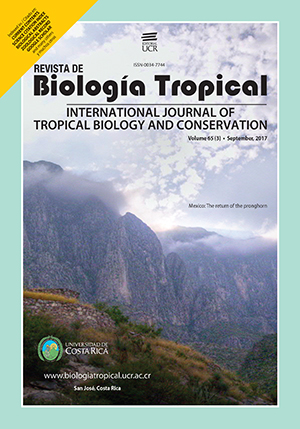Resumen
La reintroducción de especies desaparecidas de mamíferos en sus hábitats históricos ha sido recientemente de gran interés. Desde 1967 se han realizado varios intentos de reintroducción del berrendo en México, ninguno ha sido exitoso. El objetivo de este estudio es proveer información que contribuya a evaluar el éxito de la liberación. El estudio se sustentó en el monitoreo de 100 individuos (70 hembras y 25 machos) capturados en Nuevo México E.U.A. y liberados en Maderas del Carmen, Coahuila, en dos etapas, el primer grupo de 45 individuos (20 hembras, 25 machos) liberado en la vertiente occidental de Maderas del Carmen en marzo 2009 y el segundo grupo en marzo 2010 con 55 individuos más (50 hembra, 5 machos). Se comparó la dispersión y mortalidad entre el método de liberación de adaptación vs liberación inmediata. La liberación con adaptación para esta especie dio un resultado altamente significativo (χ2= 2, α= 0.05, p= 0.0001). Los resultados de los métodos de liberación inmediata fueron de 23 % de mortalidad y 46 % de dispersión y los de la liberación de adaptación fueron de 4 y 13 % respectivamente. El método de liberación de adaptación es más benévolo que la liberación inmediata ayudando a reducir la dispersión y mortalidad por miopatía en translocaciones de berrendo. Por lo que el método de liberación con adaptación se recomienda utilizarlo en futuras liberaciones de berrendo ya que demuestra que más del 50 % de los berrendos procedentes de liberaciones inmediatas mueren por estrés de captura o se dispersan y con ello, se reducen las posibilidades de éxito.
Citas
Baker, R. H. (1956). Mammals of Coahuila Mexico. Kansas, E.U.A.: Museum of Natural History.
Baker, R. H. (1958). The future of wildlife in northern Mexico a problem in conservation education. Transactions of the 23rd North American Wildlife Conference, 23, 567-575.
Cancino, J. (2005). Familia Antilocapridae, Berrendo. En G. Ceballos & O. Giselle (Eds.), Los Mamíferos silvestres de México (pp. 502-504). México, D.F., México: Comisión Nacional para el Conocimiento y Uso de la Biodiversidad.
Convención sobre el Comercio Internacional de Especies Amenazadas de Fauna y Flora Silvestres. (2010). Apéndices. Recuperado de https://cites.org/esp/app/index.php
Eastridge, R., & Clark, J. D. (2001). Evaluation of 2 soft release techniques to reintroduce black bears. Wildlife Society Bulletin, 29(4), 1163.
Fatooh, J., Russi, T., & Goldsmith A. (1994). Pronghorn reintroduction to Mono County, California: 12 years after. Pronghorn Antelope Workshop, 16, 35-49.
Fisher, L. W. (1942). Live tramping Texas antelopes. Journal Wildlife Management, 6, 231-236.
Gibert, S. (2007). Dinámica poblacional y preferencia de hábitat de un grupo de wapitíes (Cervus elaphus) reintroducido en la Sierra Maderas del Carmen (Tesis de Maestría). U.A.N.L., Linares, México.
González, A. & Lafón, A. (1993). Distribución y estado actual del berrendo (Antilocapra americana) en México. En R. A. Medellín & G. Ceballos (Eds.), Avances en el estudio de los mamíferos de México (pp. 409-420). México D.F., México: Asociación Mexicana de Mastología, A.C.
Unión Internacional para la Conservación de la Naturaleza (2010). Red List of threatened species. Recuperado de www.iucnredlist.org
Koch, A., & Yoakum, J. (2002). Reintroduction and status of pronghorn on the Carrizo Plain National Monument and surrounding areas in southern. Pronghorn Antelope Workshop, 20, 25-41.
Leopold, A. (1959). Fauna Silvestre de México Aves y Mamíferos de Caza. México D. F., México: Instituto Mexicano de Recursos Renovables.
Martínez, L. (2009). Site fidelity and post release movements of translocated mule deer in northern Coahuila, Mexico (Tesis de Maestría). Sul Ross State University, Alpine. E.U.A.
Miranda, E. P. (2000). Monitoreo de una población de berrendo (Antilocapra americana mexicana) reintroducida el noroeste de Coahuila. (Tesis Maestría). U.A.N.L. Linares, México.
Nelson, E. W. (1927). Status of Pronghorned antilope. 1922-1924. U.S. Departament Agriculture Bulletin, 1346, 1-66.
Nielson, L. (1988). Definitions, considerations, and guidelines for translocation of wild animals, En L. Nielsen & R. D. Brown (Eds.), Translocation of wild animals (pp 12-52). Kingsville, E.U.A.: Caesar and Kleberg Wildlife Research Institute.
Secretaría de Medio Ambiente y Recursos Naturales y Pesqueros [SEMARNAP]. (1997). Programa de Manejo del Área de Protección de Flora y Fauna Maderas del Carmen, Coahuila, México. México D.F., México: Instituto Nacional de Ecología.
Secretaría del Medio Ambiente y Recursos Naturales Pesqueros [SEMARNAP]. (2010). Norma Oficial Mexicana NOM-059-SEMARNAT-2010 Diario Oficial de la Federación. Recuperado de http://www.profepa.gob.mx/innovaportal/file/435/1/NOM_059_SEMARNAT_2010.pdf
Secretaría de Medio Ambiente y Recursos Terrestres [SEMARNAT]. (2009). Programa de acción para la conservación de la especie: Berrendo (Antilocapra americana). México D.F., México: Comisión Nacional de Áreas Naturales Protegidas.
O’Gara, B., & Yoakum, J. (2004). Pronghorn Ecology and Management. Boulder, E.U.A.: University Press of Colorado.
Porter, B. (2006). Evaluation of collared peccary translocations in the Texas Hill Country (Tesis Maestría). Texas A&M University, Kingsville, E.U.A.
Valdéz, M. & Manterola, C. (2006). Reintroducción del berrendo en Coahuila. En M. Valdéz, E. Peters, & E. Palledares (Eds.), El berrendo en México acciones de conservación (pp. 97-111). México, D. F., México: Agrupación Sierra Madre.
Woolley, T. P., & Lindzey, F. G. (1994). Relative precision and sources of bias in pronghorn sex and age composition surveys. Journal Wildlife Management, 61(1), 57-63.
##plugins.facebook.comentarios##

Esta obra está bajo una licencia internacional Creative Commons Atribución 4.0.
Derechos de autor 2017 Revista de Biología Tropical






